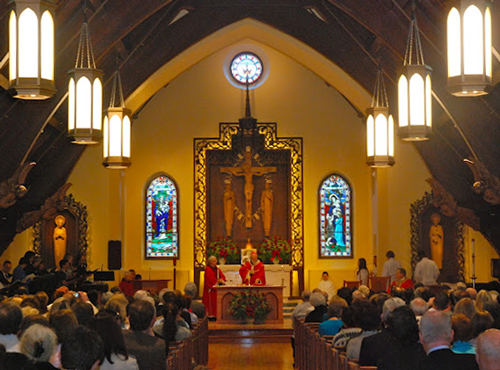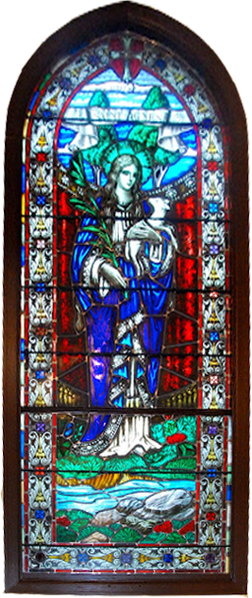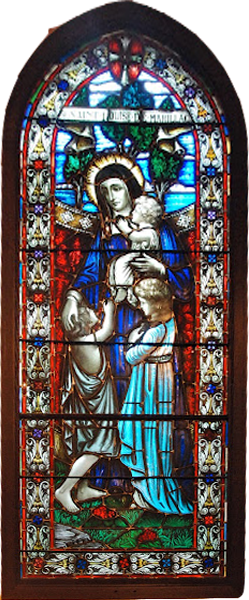St. Julia Church, Weston
Construction History
St. Julia Church was built in Weston, MA, between 1919 and 1921. The architects, Maginnis and Walsh, were nationally known as designers of Catholic churches and institutions. Construction by John Capobianco cost $50,000. A used parlor-organ was brought to the church in a horse-drawn cart.
In 1961 work began on an addition to the back of St. Julia Church to increase seating capacity. It was designed by the original architectural firm, now Maginnis, Walsh and Kennedy, and was constructed by Richard White and Sons. A basement was excavated under part of the original church for an auditorium where Masses could be said during the renovations. The newly expanded St. Julia Church could now seat 500 people. The addition created a new and larger space for the altar and included a new sacristy and the new basement used for religious education classes.
In 2011-2012 St. Julia Church was again renovated to improve the interior finishes, repair the exterior, add lighting and air conditioning, refurbish the sound system and update the sanctuary and the gathering place at the rear of the church. Parishioner Martin Dermady was the architect for the project.
Stained Glass Windows Added in 2012
 One of the most frequent comments heard in consultations leading up to the church’s renovation was a observation that the beautiful St. Julia Church needed more light. The renovation process involved exploring the possibilities for artificial lighting made possible through technological advances of recent decades. Beyond that, there was the chance for obtaining stained-glass windows salvaged from closed Church institutions of the archdiocese. In particular the Renovation Committee identified the church’s south-facing wall, just behind the tabernacle, as an area that might contain some windows able to take advantage of the southern exposure’s extended periods of daylight. The three exquisite windows on the east-facing and much shaded wall of the sanctuary, while sometimes dazzling for those who can view them from one corner of the church’s seating area, were judged able to be complemented by windows on the wall perpendicular to theirs.
One of the most frequent comments heard in consultations leading up to the church’s renovation was a observation that the beautiful St. Julia Church needed more light. The renovation process involved exploring the possibilities for artificial lighting made possible through technological advances of recent decades. Beyond that, there was the chance for obtaining stained-glass windows salvaged from closed Church institutions of the archdiocese. In particular the Renovation Committee identified the church’s south-facing wall, just behind the tabernacle, as an area that might contain some windows able to take advantage of the southern exposure’s extended periods of daylight. The three exquisite windows on the east-facing and much shaded wall of the sanctuary, while sometimes dazzling for those who can view them from one corner of the church’s seating area, were judged able to be complemented by windows on the wall perpendicular to theirs.
The stained-glass windows of St. Julia Church’s nave, though decidedly small, are gems of light and color. Each one depicts one saint surrounded by a relatively standard border of shapes and colors. Renovation Committee members considered that new sanctuary windows might be best if they related in some way to the nave windows in design, coloration and theme. This would be a challenge in dealing with available windows originally fashioned for other settings.
There was a need to find windows which could face toward and not compete with the ensemble depiction of Christ crucified, Mary and the apostle John on the rear wall of St. Julia Church. So, two windows with saints facing in the same direction would not do, and neither would figures significantly larger than those in the Calvary scene.
From the archdiocesan depository of available windows, viewable online, committee members searchedfor windows of approximately perfect size, shape, color and theme. Many collections came from churches closed around 2004, and most depicted saints. The windows, many of them cut into smaller sections, were stored in a Braintree warehouse where they were categorized and kept in cardboard sleeves.
Among the windows were several extracted not from a closed church but from a discontinued Catholic school, Immaculate Conception, which had served its North Cambridge, West Somerville and East Arlington parish until it was closed in the 1990s and some years later sold to a private non-religious school. Immaculate Conception School had once served as an orphanage conducted by the Daughters of Charity, an order of religious women founded by St. Vincent de Paul and his collaborator St. Louise de Marillac in seventeenth-century France. The two windows judged best from this collection were one showing Louise with three young children and another portraying St. Agnes holding a lamb and a palm branch.
The windows, as found in the warehouse, not surprisingly were dirty and were not particularly striking in their stored state. Lyn Hovey, the stained-glass expert who holds the collection of available windows and who had come to visit St. Julia Church, encouraged Father Evans and architect Martin Dermady to keep considering them for their craftsmanship and potential to be readied to fit St. Julia Church. Compared with some other contending windows, these were seen as of higher quality and of promise for adding strong color and complementarity.
The two chosen windows were of unequal length, but were similar in that each had at its top a rounded arch, appropriate in a Romanesque church but not in a Gothic. Lyn Hovey considered the possibilities for reformulating the windows without losing their striking qualities, and he produced a mock-up from which the finalized windows were crafted. As viewed in St. Julia Church, the two windows show all the beauty and majesty of their original state, but they now match each other well and also fit the architectural style of their new home. The rounded arch became a lancet, the pointed arch which is proper to a Gothic building such as St. Julia Church.
A third and smaller window, round-shaped to correspond to the larger rose window of the northern wall of the church, brings into the church a touch of light on high. It is designed also to form a backdrop to the reredos tower that is topped with the dove, the symbol of the Holy Spirit. The blue and white colors evoke a sense of the sky and of God’s heaven.
Both windows, as would befit an orphanage but also a parish with many youth, are oriented toward young people. Agnes is a smaller figure figure than Louise, since Agnes was a teenager when she surrendered her life for her faith in Christ. Three of the figures in the other, more populated window are children surrounding Louise.
St. Agnes Window
 St. Agnes is depicted closely holding a lamb, representing Jesus, the “Lamb of God” (in Latin, Agnus Dei). Agnes was a girl of twelve who suffered martyrdom in 304 A. D. for her faithfulness to Jesus as her treasured Savior. She is said to have been subjected to horrific torture by fire, from which she emerged unblemished. She is lauded for her chastity and for embracing her sufferings and her ultimate martyrdom with complete awareness of the gift she was making to God.
St. Agnes is depicted closely holding a lamb, representing Jesus, the “Lamb of God” (in Latin, Agnus Dei). Agnes was a girl of twelve who suffered martyrdom in 304 A. D. for her faithfulness to Jesus as her treasured Savior. She is said to have been subjected to horrific torture by fire, from which she emerged unblemished. She is lauded for her chastity and for embracing her sufferings and her ultimate martyrdom with complete awareness of the gift she was making to God.
Agnes can remind us of Jesus Christ, whose own wholehearted gift of Himself on the cross is continued whenever Mass is celebrated, as it is in the sanctuary beneath this window of St. Agnes. This saint also reminds us of St. Julia, also a virgin and martyr, from a few centuries later. Julia presumably was inspired to accept martyrdom for the Lord on account of the prior witness of great martyr-saints like St. Agnes and on account of Jesus’ own willingness to be the lamb of sacrifice.
The palm branch she holds is the standard symbol for Christian martyrdom. Palms connote victory, as in a race, and martyrs are very frequently depicted as holding palm branches.
The Opening Prayer of the Mass for the obligatory memorial of St. Agnes, on her feast day of January 21, reads: “Almighty and ever-living God, who choose what is weak in the world to confound the strong, mercifully grant, that we, who celebrate the heavenly birthday of your Martyr Saint Agnes, may follow her constancy in the faith.”
The name of St. Agnes is found in the short list of saints commemorated in the ancient and still-prayed First Eucharistic Prayer. This inclusion points to the esteem in which her name and her self-gift were held by Christians in the earliest centuries.
St. Louise Window
 St. Louise de Marillac (1591-1660) is shown with children who trustingly regard her while she looks lovingly toward them. Louise was born in Paris. By the time she was 13 years old, both her parents had died. After being educated in a convent school and considering consecrated religious life, she ultimately married a young nobleman, and she bore a son in 1613. Once widowed, she devoted her life to prayer and charity.
St. Louise de Marillac (1591-1660) is shown with children who trustingly regard her while she looks lovingly toward them. Louise was born in Paris. By the time she was 13 years old, both her parents had died. After being educated in a convent school and considering consecrated religious life, she ultimately married a young nobleman, and she bore a son in 1613. Once widowed, she devoted her life to prayer and charity.
Greatly influenced by Saints Francis de Sales and Vincent de Paul, Louise practiced her faith fully and maintained a strong commitment to abandoned children, the poor and the imprisoned. In 1633, along with Vincent de Paul, Louise founded a community of sisters, the Daughters of Charity, whose work was and is dedicated largely to the poor, the homeless and the orphaned. Louise was canonized in 1934.
Having these two great saints depicted so prominently can remind us that in St. Julia Parish we aim to respect and care for the persons and the faith development of young people and of those who are in any way dependent and vulnerable.
